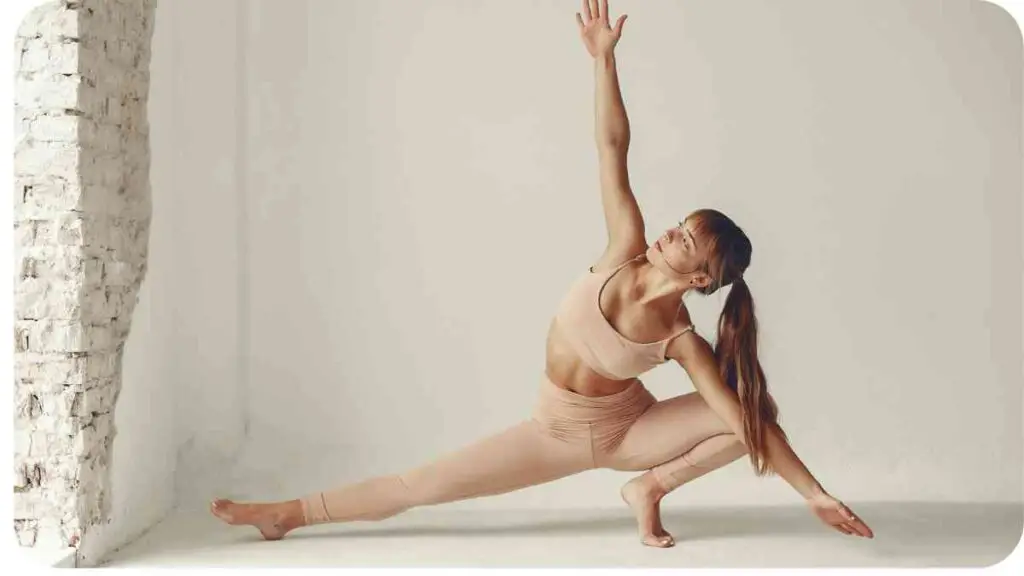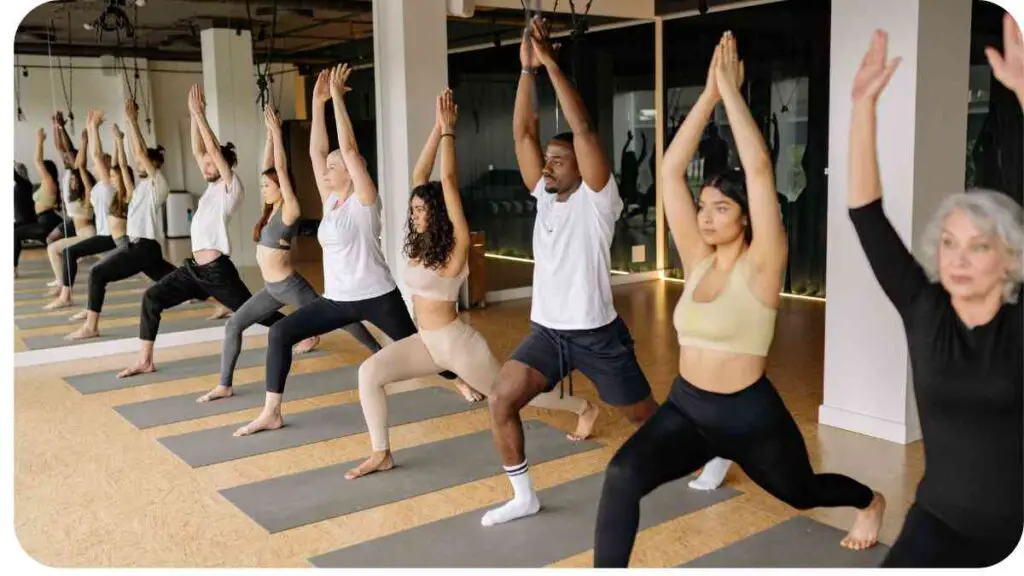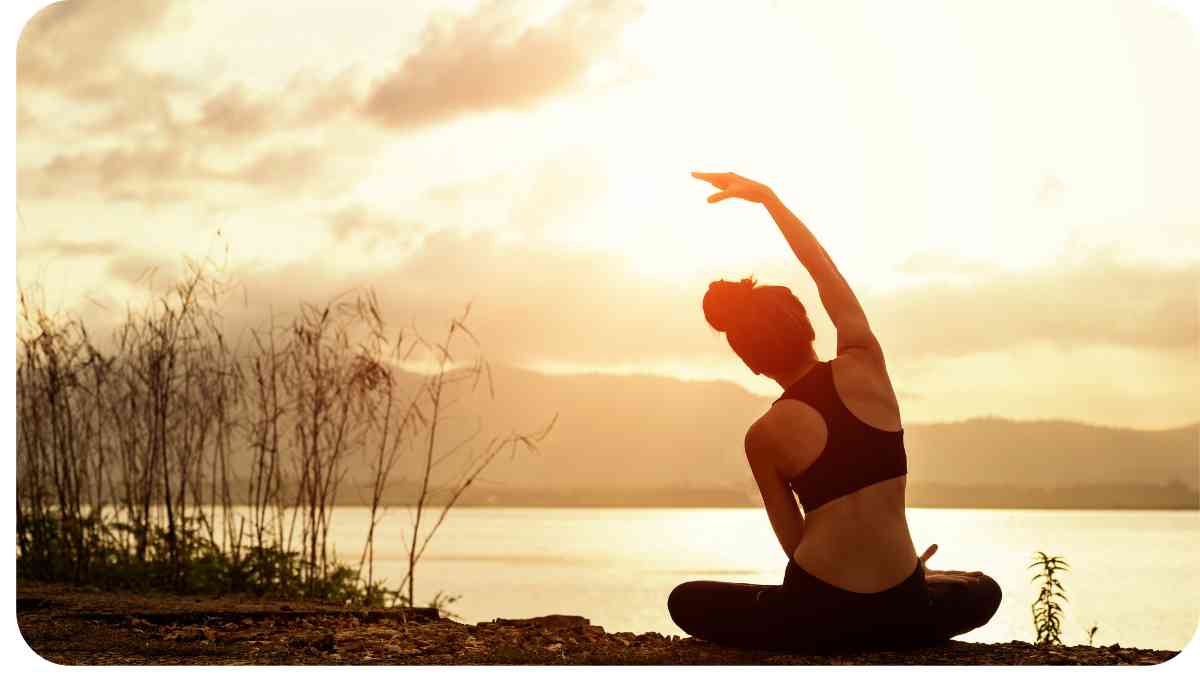The benefits of yoga are well known. If you’re not familiar, it’s a mind-body practice that can help reduce stress, improve flexibility and balance, and boost self-confidence. The best part is that it doesn’t require any equipment or special clothing—just an open mind and some space to move around in. But what if you could take your yoga practice outside?
The natural world has been shown to have therapeutic effects on our minds and bodies; incorporating nature into your yoga routine will help you build strength while also gaining serenity. In this article we’ll explore different ways to do just that!
| Takeaways |
|---|
| 1. Practicing yoga in nature promotes relaxation and mindfulness. |
| 2. Outdoor yoga offers a unique connection to the natural world. |
| 3. Forest bathing can reduce stress and enhance mental well-being. |
| 4. Combining yoga with activities like hiking can improve physical and mental fitness. |
| 5. Different breathing techniques can enhance your connection with nature. |
| 6. Nature retreats provide opportunities for immersive outdoor yoga experiences. |
| 7. Meditation in nature can calm the mind and heighten awareness. |
| 8. Explore your surroundings to discover new places for yoga and meditation. |
| 9. Get creative with props using natural elements like rocks and logs. |
| 10. Always leave no trace and respect the environment during outdoor yoga. |
Practice outside
You’re probably already practicing outside, but do you know how to make the most of your outdoor time?
When you practice outside in nature, you can:
- Unwind from a stressful day and get back to your center.
- Make friends with yourself.
- Become more mindful of the world around you and appreciate its beauty.
- Feel connected to other yogis who like to practice on the beach or in a forest as much as you do!
In the world of yoga and spirituality, it’s crucial to tap into the deeper meaning of your practice. Through connecting with nature, you can find profound insights that enhance your spiritual journey.
Try some outdoor yoga

- Look for a park or other green space.
- Do some research before you go, so you know what you’re getting into.
- Bring a mat, towel and water. The sun can be intense, so be sure to wear sunscreen if it’s sunny outside.
- Make sure it’s safe to practice there—look for nearby cars and pedestrians who might step on your mat while they’re walking by! Also make sure that the trees are too high up on the trunk (or far away) before practicing under them; otherwise their branches will hit against your head during downward dogs, which is less than ideal.
- Be aware of your surroundings: Are there any bugs flying around? Snakes? Bears?! A few minutes before class starts is usually enough time to take stock of what could potentially happen in case something goes awry during class (inexplicably bad weather) so that proper precautions can be taken accordingly—but don’t worry too much about what could go wrong because chances are slim! Just keep an eye out for anything unusual happening nearby or coming towards yourself/another student(s).
Try forest bathing
- Forest bathing is a Japanese concept that involves going into nature and spending time there.
- Many people say that forest bathing can relieve stress and anxiety, help you sleep better, make you more creative, lower blood pressure, promote good digestion and increase your energy levels. It’s also said to reduce feelings of depression.
- According to scientists who have studied the effects of forest bathing on humans (like this study), spending time in nature can improve mental health by reducing stress hormones like cortisol while increasing dopamine levels in the brain—which helps us feel happy.
- To do it yourself: Pick a spot near where you live or work that’s accessible by foot or bike (or taking public transportation). Find someplace quiet where you feel comfortable being alone for about an hour with no distractions from the outside world (no cell phones!). Close your eyes and just listen to what sounds are around you—try not to think about other things too much during this time! If possible, try doing something active like walking through densely wooded areas or sitting down next to a stream so as not only use all five senses but also get some physical exercise while doing so!
Unlocking the secrets of ancient yoga practices is a path to ultimate enlightenment. Incorporating elements of nature into your yoga routine can transport you to a higher state of consciousness.”
Add yoga to your hike
Why not incorporate yoga into an already enjoyable activity? Hiking is a great way to get outside, enjoy nature and burn some calories. But if you’re looking to add more benefits than just the physical, yoga can help with all of those things! Plus, it’s also a great way to improve your posture and balance while reducing stress and improving breathing.
Simply find a quiet spot on the trail where you’ll be alone or away from traffic noise (and make sure it’s safe). Once settled in, take some deep breaths as you begin stretching yourself out on the ground or leaning against a tree trunk. This will help stretch your muscles out before heading back out onto the trail again!
Learn how to breathe in different places
Breathing is a skill that can be cultivated. You can breathe in different ways, depending on your needs and state of mind. For example, if you are feeling calm and centered, a deep diaphragmatic breath will help you stay present to the moment. If you are feeling stressed or uncomfortable with your body, shaking out some tension in your breath will help you relax and calm down so that you can move forward with more ease.
Breathing is connected to all aspects of life: body, mind and spirit (or soul). We breathe every day but most people don’t think about their breaths unless something goes wrong—like when we forget how many times per minute our hearts beat!
If we want to connect with nature during yoga practice we should learn how to breathe deeply everywhere: outdoors on a hike through the mountains; indoors at home after work; sitting cross-legged at an outdoor café sipping chai tea latte while reading a book–there are many beautiful places where one can feel connected by simply taking time out each day just sit quietly pay attention not only what goes into mouth but also what comes out through nostrils as well as ears (i’m looking at YOU hearing aids).
Do a nature retreat
A nature retreat is an outdoor experience that allows you to immerse yourself in the natural world. It may be held at a nearby park or botanical garden, or it could take place on a private property that has been carefully restored to its natural state. The purpose of these retreats is to reconnect with ourselves and with the earth through yoga, meditation, and other self-care activities.
You can do a nature retreat for any reason—to celebrate an anniversary or birthday; try something new; spend time with family; learn about sustainable living practices—but whatever your motivation, there are plenty of reasons why you should consider doing one!
Discover the transformative and spiritual power of yoga. By immersing yourself in nature during your practice, you can experience life-altering changes that extend beyond the mat.
Meditate on a rock or tree stump.
Meditation is a simple and powerful way to connect with nature and quiet your mind. Many people think of meditation as sitting cross-legged on a cushion in the lotus position, but there are many ways you can meditate besides this. Meditation can be practiced anywhere—even while going for a walk or taking a shower!
You can do it while walking or driving by focusing on how your body feels when you’re moving, noticing how the wind brushes against your skin, paying attention to sounds around you. As an added bonus: You’ll feel more relaxed and alert throughout the day! The benefits of meditation are vast; studies have shown that regular practitioners experience lower stress levels and better focus than their non-meditating counterparts.
Finding inner peace through yoga is the ultimate goal for many. The guide to spiritual growth emphasizes the role nature plays in achieving harmony within and with the world around you.”
Explore
Once you’ve made the decision to incorporate nature into your yoga practice, it’s time to explore! Oftentimes, we are so focused on the task at hand that we forget to look at what’s around us. Take some time before or after class (or both!) and walk in whatever direction you feel drawn. If you have never been hiking before, try going on a short trail first—get used to how your body reacts in different environments. You might even find yourself having a new favorite place for meditating or going for a run!
Get creative with your choice of yoga props

The best props to use are the ones you have on hand. If your home is devoid of yoga props, don’t worry! There are many simple things you can use as props in your home. Use a stick instead of a block and a rock instead of a bolster. The most important thing is to get creative with your choice of yoga props.
When practicing outside or in nature, if there’s no tree stump within reach that’s tall enough for you to balance on it, improvise! Simply bend down at the hip and place one foot atop an elevated surface like a log or rock (for instance). Then place your hands firmly on top of any nearby stable object such as another log or even another person—with their permission, of course! Just be sure not to put yourself in danger by balancing way too far forward over waterfalls or other hazards where falling could result in serious injury.”
Leave a trace
When you’re practicing yoga outdoors, it’s important to leave a trace—don’t damage the environment. For example, if you’re using rocks as props in your practice, be sure to replace them where they came from. This can help prevent an erosion of the earth or other damage to the ecosystem by preventing erosion and keeping everything in place as it should be.
It’s also important to be mindful of what you bring with you when practicing yoga outdoors; don’t bring anything that isn’t biodegradable. And if there are any nearby plants or animals (like bees), make sure not to disturb them!
Explore the profound spiritual benefits of yoga as it helps you connect with your inner self. Nature’s influence on yoga can deepen this connection and lead to spiritual growth.
Use nature to build strength and gain serenity.
Use nature as a source of strength and serenity.
- Nature can help us build strength. Our ancestors relied on the strength of their bodies to survive, and they spent time outdoors every day—often in harsh conditions—to keep their bodies strong. Today, we’re much more likely to be sitting at our desk for 8 hours each day than we are engaged in physical labor or even just walking outside for a few minutes. The result is that many of us have become less physically fit than our ancestors were because we don’t put ourselves through enough rigorous activity on a regular basis.
- Nature can also be used as a source of serenity. Researchers from Harvard Medical School found that spending time outside lowers anxiety levels by almost 40 percent!
Conclusion
I hope this guide has inspired you to incorporate nature into your yoga practice. We all know how important it is to take care of our bodies and minds, but sometimes it can be hard to get back into our routines when the weather doesn’t cooperate. If you need some help getting started, feel free to contact me anytime!
Further Reading
- Medical News Today – The Health Benefits of Yoga
- Explore the various health benefits of practicing yoga, from stress reduction to improved flexibility, as explained by Medical News Today.
- The New York Times – Beginner’s Guide to Yoga
- The New York Times offers a beginner’s guide to yoga, providing insights and tips for those new to the practice.
- Yoga Basics – Yoga Practice and Lifestyle
- Dive deeper into yoga practice and lifestyle with Yoga Basics, where you’ll find resources and information to enhance your yoga journey.
FAQs
What are the basic yoga poses for beginners?
Yoga poses for beginners typically include poses like Downward Dog, Child’s Pose, and Cobra. These poses help build a foundation for your yoga practice.
How often should I practice yoga?
The frequency of yoga practice varies from person to person. It’s recommended to start with a few sessions per week and gradually increase as you become more comfortable.
Can yoga help with stress reduction?
Yes, yoga is known for its stress-reducing benefits. The combination of physical postures, breathing techniques, and meditation can help alleviate stress and promote relaxation.
What equipment do I need for yoga?
For most yoga sessions, you’ll only need a yoga mat. However, some props like blocks and straps can be helpful for certain poses and stretches.
Is yoga suitable for all fitness levels?
Yes, yoga is inclusive and adaptable. There are different styles and levels of yoga, making it accessible to individuals of varying fitness levels and abilities.

Hello, my name is Hellen James! I am a yoga teacher and writer who loves to share information about how you can achieve a more fulfilling life. I have been practicing mindfulness, yoga, and meditation for over 10 years. My passion for these practices has led me to teach them to others.

